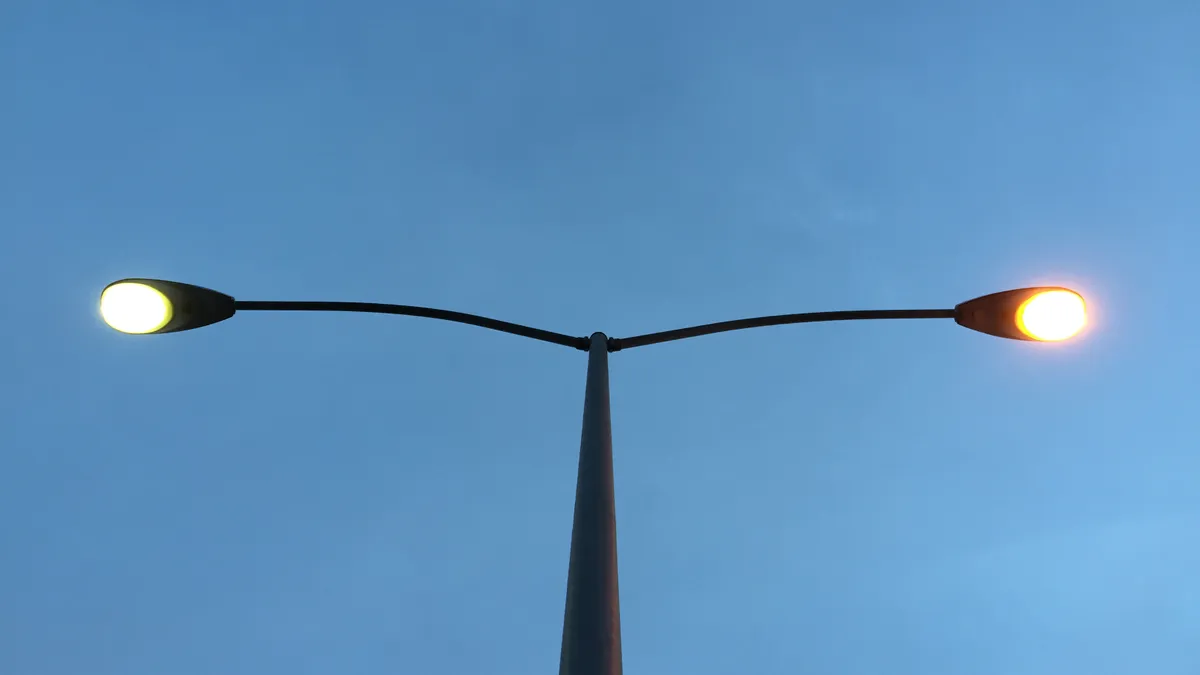Dive Brief:
- Investments in smart street lighting could total $8.2 billion over the next decade, according to a survey from smart infrastructure market intelligence firm Northeast Group LLC. Utilities are considering more efficient and connected street lighting as a way to help manage system demand and lower carbon emissions.
- Northeast Group surveyed 314 large U.S. cities and found 185 cities (59%) are in the process of converting streetlights to LEDs, while 59 cities (19%) are considering smart street lighting. While LED conversion is the "largest piece of the pie" in terms of smart streetlight investment, there is increasing interest in two other areas: remote streetlight monitoring, and using streetlights to support broader internet of things (IoT) applications like air quality or traffic sensors, Northeast Group President Ben Gardner told Smart Cities Dive.
- The survey also found an uptick in cities buying back their streetlights from utilities, and found that prices of smart streetlight infrastructure have stabilized as more technology has come onto the market.
Dive Insight:
Northeast Group found steady growth in the smart street lighting market since its last survey in 2018, despite costs and hesitations from some cities.
"I think we're seeing a more clear understanding of the benefits of doing these types of things," he said. "And I think [cities] are also realizing that street lighting is really going to be the critical linchpin to the broader smart city space."
Potential savings are significant. According to the Institute of Electrical and Electronics Engineers, street lighting in the United States accounts for 30% all the energy used to generate electricity for outdoor lighting while another 60% goes toward lighting parking lots and garages.
And acccording to a 2015 study by Navigant, now Guidehouse, the U.S. could save 662 trillion BTUs by converting all remaining non-LED outdoor lighting to LEDs.
Cities and utilities are taking a close look.
Cleveland, Ohio, for example, announced last year it would adopt a wireless network to convert its 61,000 streetlights into a smart network. Meanwhile, advocates have talked up the benefits of smart streetlights and technologies that can be integrated with them, which is already turning heads; in 2018, Berlin-based Ubitricity won the first NYCx Climate Action Challenge for its technology that can convert existing light poles into electric vehicle (EV) charging stations.
Smaller cities are experimenting with smart streetlights, too. Just last week, Spencer, Massachusetts, a town of 12,000 people, announced it is converting its streetlights to LEDs and will add road condition monitoring as part of that project.
In 2014, Florida Power & Light rolled out a plan to link 75,000 street lights to its smart grid network.
Smart streetlights are not without controversy, however. The watchdog group San Diegans for Open Government (SDOG) sued the City of San Diego last year over its Smart Streetlights Program in a lawsuit that is still pending. Questions have been raised in San Diego over data collection and whether that data is truly useful for transit and mobility planners.
Meanwhile, some have raised concerns over the costs of smart streetlights and if there's even a business case for some of their more futuristic uses.
Gardner predicted cities will continue to adopt smart streetlight technology as the market matures, and as local leaders see the benefits of converting to LEDs while simultaneously upgrading offerings in a bid to become smarter.
"We're seeing cities are finally waking up to the benefits of smart street lighting and realizing that if they're going to do an LED conversion ... it probably makes sense when they change out that streetlight to also put a smart node on the streetlight so you can roll a truck one time rather than two times, so you get some efficiency in deployment," Gardner said.
Smart streetlighting could also benefit from a future stimulus package as elected officials look to reboot the economy with an eye on technology amid coronavirus (COVID-19) pandemic recovery.
















